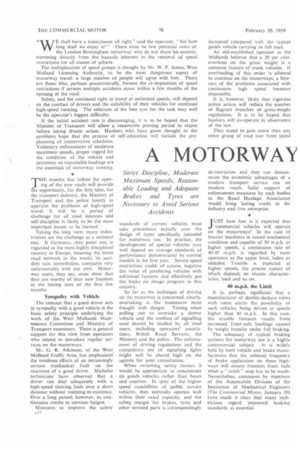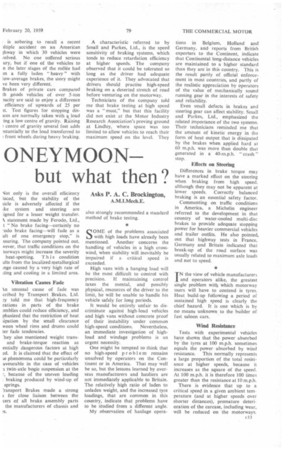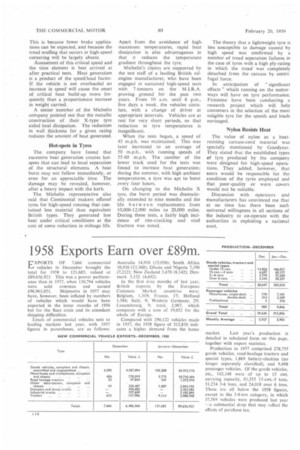A MOTORWAY ONEYMOON but what then ?
Page 48

Page 49

Page 50

If you've noticed an error in this article please click here to report it so we can fix it.
Asks P. A. C. Brockington, A.M.I.Mech.E.
" E shall have a honeymoon all right," said the operator, "but how long shall we enjoy it? " There must be few potential users of the London-Birmingham motorway who do not share his .anxiety, stemming directly from the hazards inherent in the removal of speed restrictions for all classes of vhicle.
The multiplication of speed groups is thought by Mr. W. P. James, West Midland Licensing Authority, to be the most dangerous aspect of motorway travel: a large number of people will agree with hitt. There are those who, perhaps pessimistically, foresee the re-imposition of speed restrictions if serious multiple accidents occur within a few months of the opening of the road. .
Safety, and the continued right to travel at unlimited speeds, will depend . on the conduct of drivers and the suitability of their vehicles for continual high-speed running. The selection of the best tyre for the task may well lae the operator's biggest difficulty.
MHE months that follow the open
ing of the new roads will provide tine opportunity, for the first time, for the transport industry, the Ministry of Transport and the police jointly to appraise the problems of high-speed travel. It will be a period of challenge for all road interests and self-discipline is likely to be the most important lesson to be learned.
Taking the long view, many industrialists see the challenge as a national one. If Germany, they point out, is regarded as the most highly disciplined country in Europe, boasting the finest road network in the world, its accident rate, nevertheless, compares very unfavourably with our own. Motorway Users, they say, must show that they are worthy of their new freedom in the testing time of the first few months.
Sympathy with Vehicle
The concept that a good driver acts in sympathy with a goad vehicle is the basic safety principle underlying the work of the West Midlands Maintenance Committee and Ministry of Transport examiners. There is general support for this view from operators who intend to introduce regular services on the motorways.
Mr. G. R. Atkinson, of the West Midland Traffic Area, has emphasized the insidious effects of an increasingly serious mechanical fault on the reactions of a good driver. Michelin technicians have observed that a driver can deal adequately with a high-speed steering fault over a short distance without realizing its existence. Over a long period, however, its con tinuance results in nervous fatigue. -Measures to improve the safety 12 standards of current vehicles must take precedence initially over the design of types specifically intended for motorway use. In practice, the development of special vehicles may well depend on average standards of performance demonstrated by normal models in the first year. Severe speed restrictions could, of course, negative the value of producing vehicles with advanced features and effectively put the brake on design progress in this country.
So far as the technique of driving on the motorway is concerned, clearly, overtaking is the manceuvre most fraught with danger. Timing when pulling out to overtake a slower vehicle and the method of signalling used should be studied by all road users, including operators' associations, British Road Services, the Ministry and the police. The enforcement of driving regulations and the compulsory use of signalling lights might well 'be placed high on the agenda for joint consultation.
When reviewing safety factors it would be appropriate to concentrate on goods vehicles rather than buses and coaches. In spite of the higher speed capabilities of public service vehicles, they normally operate well within their rated capacity, and the safety margin for brakes, tyres and other stressed parts is correspondingly increased compared with the typical goods vehicle carrying its full load.
An old-established operator in the Midlands believes that a 20 per cent. overload on the gross weight is a common feature of trunk vehicles. If overloading of this order is allowed to continue on the motorways, a forecast of the problems associated with continuous high speed becomes impossible.
It is, however, likely that vigorous police action will reduce the number of flagrant breaches of gross-weight regulations. It is to be hoped that hauliers will co-operate in observance of the law.
They stand to gain more than any other group of road user from speed de-restriction and they can demonstrate the economic advantages of a modern transport service run on modern roads. Solid support of enforcement measures by such bodies as the Road Haulage Association would bring lasting credit to the industry and free enterprise.
JUST how fast is it expected that commercial vehicles will operate on the motorways? In the case of heavier machines in sound mechanical condition and capable of 50 m.p.h. or higher speeds, a continuous rate of 40-45 m.p.h. is regarded by most operators as the upper limit, laden or unladen. Trouble is expected at higher speeds, the precise nature of which depends on chassis characteristics, load and so on.
40 m.p.h. the Limit
It is, perhaps, significant that a .manufacturer of double-deckers views with some alarm the possibility of such vehicles being driven at speeds higher than 40 m.p.h. In this case, the trouble foreseen results from increased front-axle loadings caused by weight transfer under full braking.
The adequacy of typical braking systems for motorway use is a highly controversial subject. It is widely held by both vehicle and brake manufacturers that the reduced frequency of brake application on these highways will ensure freedom from fade when a "crash" stop has to be made. Nevertheless, comments by members of the Automobile Division of the Institution of Mechanical Engineers (The Commercial Motor, January 30) have made it clear that many technicians regard improved braking standards as essential is sobering to recall a recent iltiple accident on an American thway in which 30 vehicles were rolved. No one suffered serious ury, but if one of the vehicles to n the later stages of the melee had en a fully laden " heavy " with low-average brakes, the story might ye been very different.
Brakes of private cars compared th goods vehicles of over 5-ton iacity are said to enjoy a difference efficiency of upwards of 25 per it. Test figures for stopping disices are normally taken with 4., load ing a low centre of gravity. Raising L centre of gravity several feet adds istantially to the load transferred to L front wheels during heavy braking.
*lot only is the overall efficiency Luced, but the stability of the tide is adversely affected if the .ke system and steering are igned for a lesser weight transfer. k statement made by Ferodo, Ltd., t "No brake facing—certainly no -odo brake facing—will fade as a ult of one emergency stop," is ssuring. The company pointed out, vever, that traffic conditions on the torways might increase the severity heat-spotting. This condition Lilts from the localized metallurgical Lnge caused by a very high rate of Lting and cooling in a limited area.
Vibration Causes Fade
lin unusual cause of fade was cribed by Transport Brakes, Ltd. ey told me that high-frequency rations in parts of the brake amblies could reduce efficiency, and phasized that the restriction of heat ;ipation by the small clearance ween wheel rims and drums could ter fade tendencies.
hey also mentioned weight trans and brake-torque reaction as entially dangerous factors at high ed. It is claimed that the effect of ie phenomena could be particularly avourable in the case of vehicles twin-axle bogie suspension at the -, because of the uneven loading . braking produced by wind-up of springs.
'ransport Brakes made a strong for close liaison between the cers of all brake assembly parts the manufacturers of chassis and !s.
A characteristic referred to by Small and Parkes, Ltd., is the speed sensitivity of braking systems, which tends to reduce retardation efficiency at higher speeds. The company observed that it could be tolerated so long as the driver had adequate experience of it. They advocated that drivers should practise high-speed braking on a deserted stretch of road before venturing on the motorway.
Technicians of the company told me that brake testing at high speed was a "must," but that this facility did not exist at the Motor Industry Research Association's proving ground at Lindley, where space was too limited to allow vehicles to reach their maximum speed on the level. They
also strongly recommended a standard method of brake testing.
SOME of the problems associated with high loads have already been mentioned. Another concerns the handling of vehicles in a high crosswind, when stability will inevitably be impaired if a critical speed is exceeded.
High vans with a hanging load will be the most difficult to control with precision. If maintaining control taxes the mental, and possibly physical, resources of the driver to the limit, he will be unable to handle his vehicle safely for long periods.
It would be entirely unfair to discriminate against high-load vehicles and high vans without concrete proof of their instability under common high-speed conditions. Nevertheless, an immediate investigation of highload and windage problems is an urgent necessity.
One might be tempted to think that no high-speed pr oblem remains unsolved by operators on the Continent or in America. That may well be so, but the lessons learned by overseas manufacturers and hauliers are not immediately applicable to Britain. The relatively high ratio of laden to unladen weight, and the increased tyre loadings, that are common in this country, indicate that problems have to be Studied from a different angle.
My observation of haulage opera
tions in Belgium, Holland and Germany, and reports from British exporters to the Continent, indicate that Continental long-distance vehicles are maintained to a higher standard than they are in this country. This is the result partly of official enforcement in most countries, and partly of the realistic appreciation by operators of the value of mechanically sound running gear in the interests of safety and reliability.
Even small defects in brakes and steering gear can affect stability. Small and Parkes, Ltd., emphasized the related importance of the two systems. Their technicians reminded me that the amount of kinetic energy in the form of heat output that is dissipated by the brakes when applied hard at 60 m.p.h. was more than double that generated in a 40-m.p.h. " crash " stop.
Effects on Steering
Differences in brake torque may have a marked effect on the steering when braking from high speed, although they may not be apparent at lower speeds. Correctly balanced braking is an essential safety factor.
Commenting on traffic conditions in America, a Michelin engineer referred to the development in that country of water-cooled multi-disc brakes to provide adequate stopping power for heavier commercial vehicles and trailer outfits. He also pointed, out that highway tests in France. Germany and Britain indicated that break-up of the road surface was usually related to maximum axle loads and not to speed.
IN the view of vehicle manufacturers and operators alike, the greatest single problem with which motorway users will have to contend is tyres. Heat build-up following a period of sustained high speed is clearly the chief hazard. It is one which is by no means unknown to the builder of fast saloon cars.
Wind Resistance
Tests with experimental vehicles have shown that the power absorbed by the tyres at 100 m.p.h. sometimes equals the power absorbed by wind resistance. This normally represents a large proportion of the total resistance at higher speeds, because it increases as the square of the speed. At 100 m.p.h. it is therefore 100 times greater than the resistance at 10 m.p.h.
There is evidence that up to a critical speed in a given ambient temperature (and at higher speeds over shorter distances), premature deterioration of the carcase, including wear, will be reduced on the motorways. This is because fewer brake applications can be expected, and because the tread scuffing that occurs in high-speed cornering will be largely absent.
Assessment of this critical speed and the time element is best arrived at after practical tests. Heat generation is a product of the speed/load factor. If the vehicle is not overloaded an increase in speed will cause the onset of critical heat build-up more frequently than a proportionate increase in weight carried.
A senior member of the Michelin company pointed out that the metallic construction of their X-type tyre aided heat dissipation. The reduction in wall thickness for a given rating reduces the amount of heat generated.
Hot-spots in Tyres
The company have found that excessive heat generation creates hotspots that can lead to local separation of the structural elements. A heat burst may not follow immediately, or even for an appreciable time. The damage may be revealed, however, after a heavy impact with the kerb.
The Michelin representative also said that Continental makers offered tyres for high-speed running that contained less material than equivalent British types, They generated less heat under critical conditions at the cost of some reduction in mileage life. Apart from the avoidance of high. maximum temperatures, rapid heat dissipation is also advantageous in that it reduces the temperature gradient throughout the tyre.
Michelin's claims are supported by the test staff of a leading British oilengine manufacturer, who have been engaged in sustained high-speed tests with 7-tonners on the M.1.R.A. proving ground for • the past two years. From 10. a.m. until 6 p.m., five days a week, the vehicles circulate, with a change of driver at appropriate intervals. Vehicles are at rest for very short periods, so that reduction in tyre temperatures is insignificant.
When the tests began, a speed of 45 m.p.h. was maintained. This was later increased to an average of 50 m.p.h., with running speeds of 55-60 m.p.h. The camber of the lower track used for the tests was found to increase heat generation; during the summer, with high ambient temperatures, a tyre was apt to burst every four hours.
On changing to the Michelin X tyre, the burst period was dramatically extended to nine months and the life between replacements from 10,000-12,000 miles to 20,000 miles. During these tests, a fairly high incidence of rim-cracking and stud fracture was noted. The theory that a lightweight tyre is less susceptible to damage caused by high speed was confirmed by a number of tread separation failures in the case of tyres with a high ply-rating in which the tread was completely detached from the carcass by centrifugal force.
In anticipation of "significant effects" which running on the motorways will have on tyre performance. Firestone have been conducting a research project which will help customers in the selection of the most suikable tyre for the speeds and loads envisaged.
Nylon Resists Heat The value of nylon as a heatresisting carcass-cord material was specially mentioned by Goodyear. They stated that the established types of tyre produced by the company were designed for high-speed operations_ They added, however, that users would be responsible for the condition of the tyres employed and that poor-quality or worn covers would not be suitable.
Discussion with operators and manufacturers has convinced me that at no time has there been such universal willingness in all sections of the industry to co-operate with the authorities in exploiting a national asset.








































































































